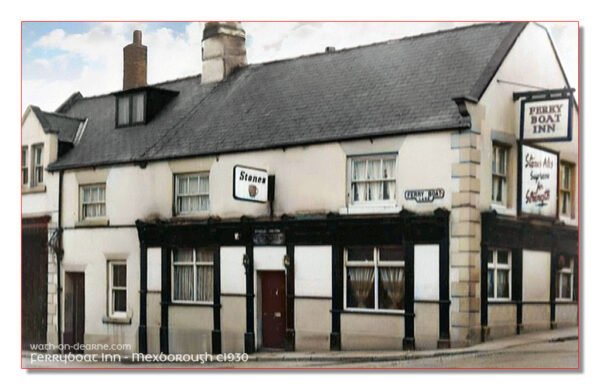 Within the heart of Mexborough, South Yorkshire echoes the long and storied history of the Ferryboat Inn, a paragon of antiquity with roots sinking deep into the rich loam of the 15th century. It’s a tale etched in weathered stone and worn timber, of a hostelry cradled within the shifting epochs, watching the centuries drift by like leaves on the river’s surface.
Within the heart of Mexborough, South Yorkshire echoes the long and storied history of the Ferryboat Inn, a paragon of antiquity with roots sinking deep into the rich loam of the 15th century. It’s a tale etched in weathered stone and worn timber, of a hostelry cradled within the shifting epochs, watching the centuries drift by like leaves on the river’s surface.
This beloved public house, in its prime, was an assemblage of memorabilia, a tapestry woven from the threads of yesteryears. Miners’ lamps, gleaming like captive stars, stood vigil in this sanctuary, harking back to days of labour and camaraderie in the bowels of the earth, their gleam curated by the tender hands of Doug and Vi Watson, the inn’s guardians.
Sacred stones and holy wood converge in the nearby St John the Baptist C of E church, a structure imprinted with the passage of time, dating back to the austere 12th century. The echo of hymns and the whispered prayers of centuries pervade its sanctum. Beside this enduring symbol of faith, a few more survivors of a pre-1800 world persist, including our dear Ferryboat Inn.
The Ferryboat, its legacy intertwined with the heart of Mexborough, stands as the eldest of pubs, extending its sheltering arms to wanderers since 1442. It was a beacon for those crossing the river’s tumultuous currents, a haven after the day’s journey. These public houses, of which the Ferryboat is a grand dame, were the lifeblood of Mexborough, birthing the titles of various trades and professions.
A sanctuary it indeed became for Mexborough’s own bard, the lauded Ted Hughes. A favoured retreat for this master of the written word, the inn nurtured the creator of verse held in high regard by his contemporaries, and adored by many who came after him. Hughes, a son of this era of industry’s heft, later sketched the River Don in his work as a torrent of vivid chemicals, seething and roiling in a macabre dance of pollution.
Crowned at the north-eastern crest of a land feature christened the Roman Ridge, Mexborough stood sentinel over the ancient Brigantian tribes. This earthen bulwark, a relic from the 1st century AD, may have risen either as a rampart against Rome’s iron fist, or a bastion against the Angles in defence of the British kingdom of Elmet.
Nestled in the Metropolitan Borough of Doncaster, Mexborough town bridges Manvers and Denaby Main, cradled by the joining of the River Don and the River Dearne. Here, the arteries of the A6023 road pulsate with the rhythm of the town, connecting it with the contiguous town of Swinton to the southwest, and Conisbrough to the east.
The name Mexborough itself is a blending of cultures and ages, melding the Old English suffix ‘burh’, a fortified place, with an Old English or Old Norse personal name, which could be Meke, Muik, Meoc, or Mjukr.
The first recorded echo of Mexborough can be found etched in the pages of the Domesday Book of 1086, referred to as Mechesburg. Before the Norman Conquest, the area was a domain of the Saxon lords Wulfheah and Ulfkil, only to be seized by the Norman Baron Roger de Busli following the Conquest. The shadowy remains of an earthwork in Castle Park are believed to be the footprint of a motte-and-bailey castle, constructed in the 11th century, a testament to the Norman dominion.
Thus, from the Ferryboat Inn to the St. John the Baptist Church, from the poetic havens to the Roman Ridge, the town of Mexborough, akin to a palimpsest, bears the marks of time, retelling its tale to those who would pause and listen.
Editor’s comment
This exquisite piece is a journey through time, weaving a rich tapestry of Mexborough’s past, from its ancient origins to its more modern history. The narrative, akin to the very rivers coursing through the town ebbs and flows with a rhythm and cadence that is thoroughly captivating. The focus on specific landmarks, like the Ferryboat Inn and St John the Baptist C of E church, adds a tangible sense of place that imbues the narrative with an authentic sense of character.
Yet, it’s the detailed account of the past that truly shines, grounding the reader in the historical context that shaped Mexborough. Whether it’s the 15th-century origins of the Ferryboat Inn or the poetic influence of Ted Hughes, every historical nugget adds a new layer to the narrative. Furthermore, the language and style used by the writer subtly mirror the period they are describing, invoking a vivid sense of atmosphere and environment. This blend of deep, insightful context and evocative storytelling breathes life into Mexborough, making this not just a history lesson, but a vibrant and compelling journey through time.

Leave a Comment